How To Focus Binoculars & Calibrate Binoculars for Your Eyes
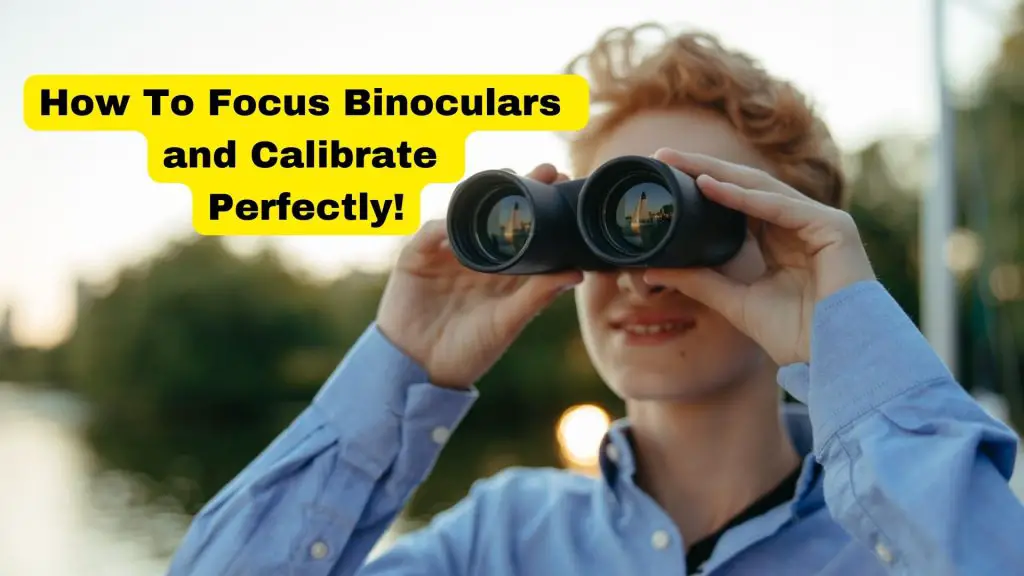
I have an uncle who decided to take up a new hobby for birdwatching and wildlife viewing.
So, for this, he had been wanting to buy a pair of binoculars for a long time and finally decided to take the plunge and purchase a high-quality pair.
He did some research and settled on a well-known brand that was recommended by other bird watchers and outdoor enthusiasts.
However, when he received the binoculars, he was disappointed to find that the image was blurry and out of focus.
He assumed that there was something wrong with the binoculars and decided to return them for a replacement.
But when the replacement arrived, he was once again disappointed to find that the image was still blurry and out of focus.
Frustrated, he decided to return the second pair as well and look for a different brand.
But before doing so, he decided to ask for advice from a more experienced bird watcher.
It was then that he realized that the problem wasn’t with the binoculars, but rather with his own eyesight.
He had not calibrated the binoculars to his own vision and was using them straight out of the box.
His friend explained to him how to adjust the diopter and focus wheel to match his individual eyesight, and he was amazed at how clear and sharp the image became.
This incident highlights the importance of understanding the mechanics of binoculars and how to use them correctly.
With proper calibration and adjustment, binoculars can provide a crystal clear view of distant objects and enhance the outdoor experience.
Now Here, As a friend, I will Guide You To Focus and calibrate Your Binoculars Correctly through this write-up.
Let’s first have a brief about binoculars working
Understanding Binoculars, Dioptres and Focus Mechanisms
To understand how to focus binoculars, it’s important to first understand the different parts that make up the device. Binoculars consist of the following parts:
- Objective lenses – These are the two lenses located at the front of the binoculars that gather and focus light.
- Prism – This is a glass or plastic wedge located inside the binoculars that flips the image so it appears right-side-up.
- Eyepiece lenses – These are the two lenses located at the back of the binoculars that magnify the image.
- Diopter adjustment – This is a small knob or lever located on one of the eyepieces that adjusts for differences in vision between the two eyes.
- Focus mechanism – This is a system of knobs or levers that adjust the focus of the binoculars, bringing distant objects into sharp focus.
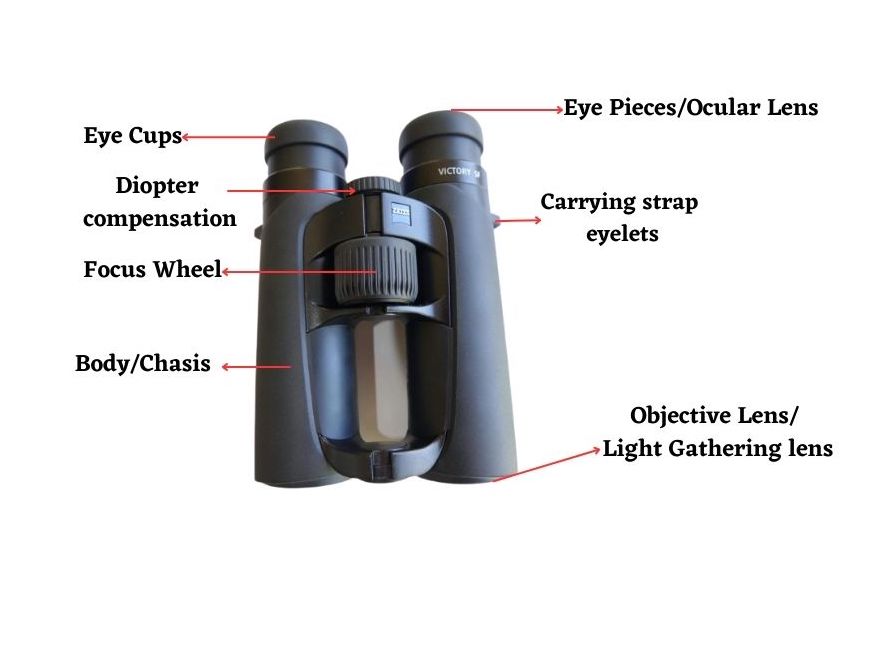
Diopters and Their Function
It’s common for people to have slightly different refractive power in their left and right eye, which can affect their vision.
To address this, binoculars often have a Diopter Adjustment.
The purpose of this adjustment is to correct any differences in eyesight between the two eyes, allowing for a clear and sharp image to be viewed.
Diopters are typically located on one or both of the eyepieces and can be adjusted by turning a small knob or lever. They are usually marked with something like the following: – 0 +.
Also, Diopters are measured in units called diopters, which is a measure of the refractive power of the lens.
A positive diopter value indicates that the lens is designed to correct for farsightedness, while a negative diopter value indicates that the lens is designed to correct for nearsightedness.
Lockable Dioptre
With lockable diopters, once the user has found their ideal diopter adjustment setting, they can lock it in place to prevent accidental changes or shifting during use.
This can be particularly useful for birdwatchers, hunters, or other outdoor enthusiasts who may be using their binoculars in rugged or unpredictable environments.
By locking in the diopter adjustment, they can ensure a consistent, clear image without having to worry about readjusting the focus.
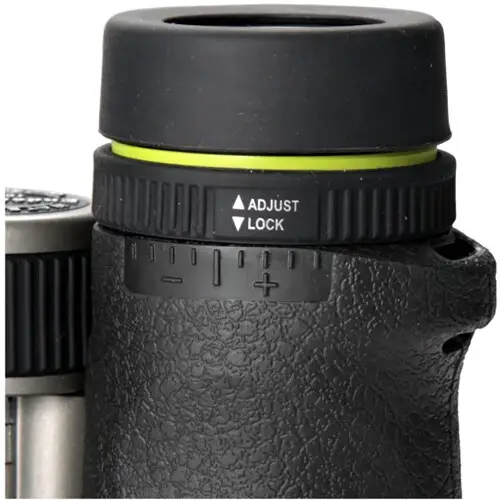
Lockable Dioptre, Image Credit: Vanguard
Focus Mechanisms and Their Types
Focus mechanisms are a system of knobs or levers that adjust the focus of the binoculars, bringing distant objects into sharp focus. There are two main types of focus mechanisms: central focus and individual focus.
Central Focus
This type of focus mechanism uses a single knob located in the center of the binoculars to adjust both eyepieces simultaneously.
This is the most common type of focus mechanism and is often found in consumer-grade binoculars.
Individual Focus
This type of focus mechanism has a separate knob or lever for each eyepiece, allowing the user to adjust the focus of each independently.
This type of mechanism is often found in very low budget or high-priced binoculars
we will discuss in detail so please keep reading!
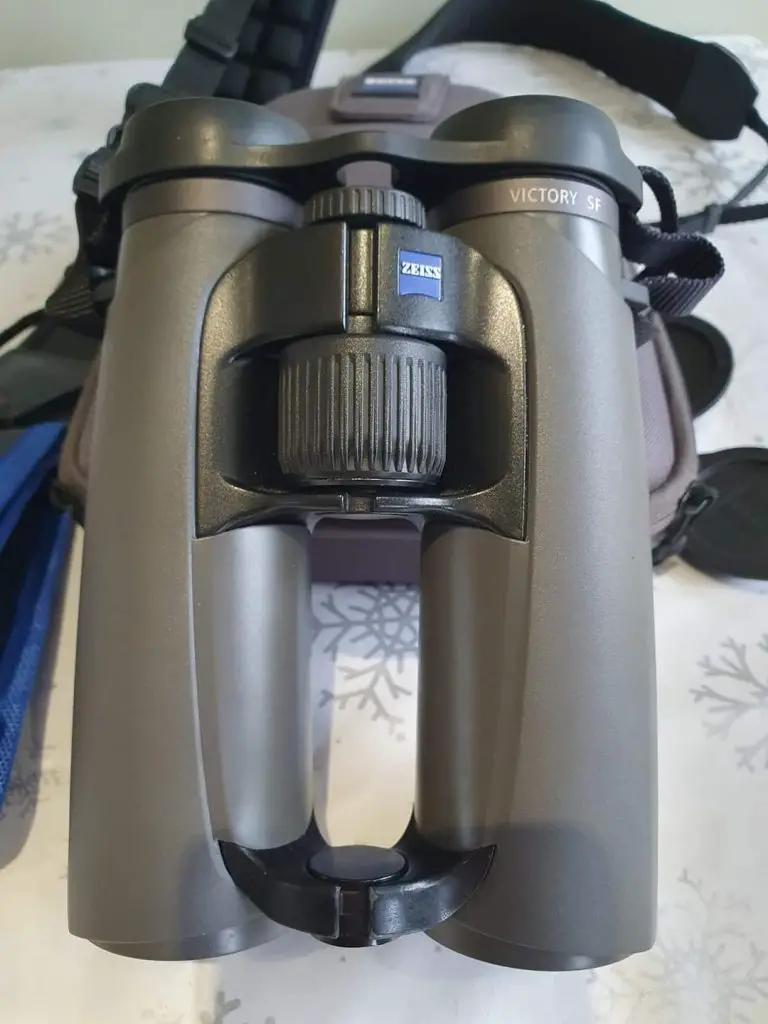
A Zeiss Centre Focusing Binoculars
Binoculars with Central Focusing System
Binoculars with central focus wheels have a single focus knob located in the center of the binoculars that adjusts the focus of both eyepieces simultaneously.
These binoculars are simple to use and are the most common type of binoculars on the market.
To use these binoculars, you simply turn the central focus wheel until the image is clear and sharp and then use dioptres adjustments for individual eye. we will see this in detail later.
Where is the Center Focus Cocated on Binoculars?
The center focus on binoculars is typically located in the center of the binoculars, on the bridge that connects the two optical tubes. It is a large wheel or knob that can be turned to adjust the focus of both eyepieces simultaneously.
It’s important to have a center focus that is large enough and has a good grip, making it easy to locate and use, even with gloves on.
The center focus wheel should be designed to provide precision when focusing, which is especially important when observing distant subjects.
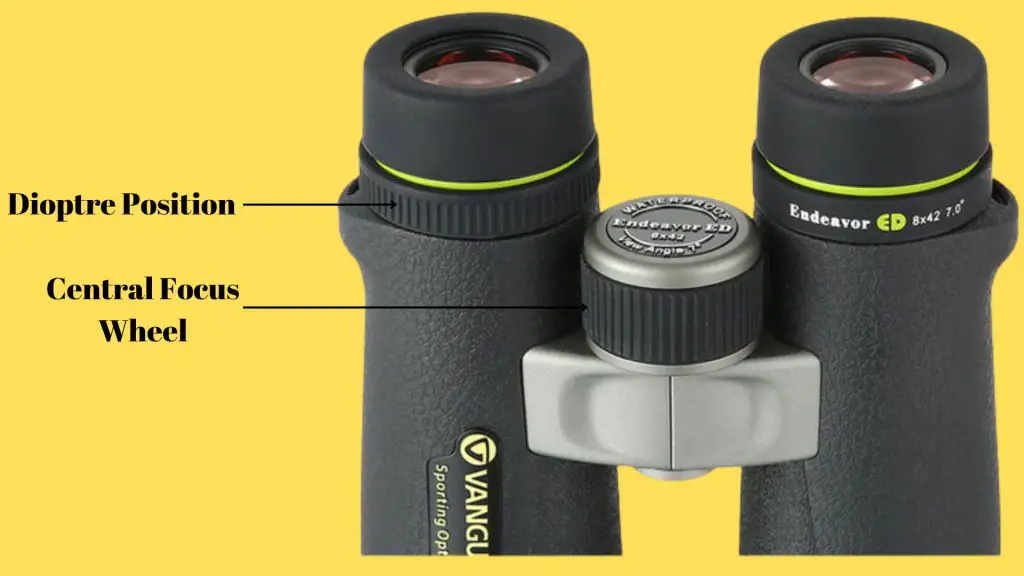
Dioptre Location in Central Focus Systems
Dioptre adjustment is typically located on one of the two eyepieces of central focus binoculars, usually on the right eyepiece.
This adjustment is often in the form of a small ring or knob located near the base of the eyepiece, and it is marked with a scale indicating the degree of adjustment in dioptres.
Some binoculars may have the dioptre adjustment on the left eyepiece or on a separate knob located between the two eyepieces.
Also In some high end binoculars like the Swarovski EL and SLC binocular models, the diopter is located just below the focus wheel, and it pops up for adjustment.
Step-by-Step Guide on How to Focus Binoculars with Central Focusing System & Right Eyepiece Dioptre
A. Step 1: Adjust the Focusing Wheel
The first step in focusing your central focus binoculars is to adjust the focusing wheel. The focusing wheel is located in the center of the binoculars and allows you to adjust the focus of both eyepieces simultaneously. To do this, follow these steps:
- Look at a distant object with both eyes open (about 10 meters away or approx 35-40ft)
- Turn the focusing wheel slowly until the object appears in focus.
- If necessary, adjust the wheel back and forth until the image is sharp and clear.
B. Step 2: Close your Right Eye
The next step is to close your right eye and focus on the same distant object with your left eye.
- Cover your right eye with your hand or the lens cap.
- Look at the object with your left eye and note if the image is in focus.
C. Step 3: Use Central Focus to Adjust Left Eye
- Look at the object with your left eye and rotate the focusing wheel until the image is in sharp focus.
- Keep adjusting the rotating wheel until the image is as clear as possible.
D. Step 4: Close Left Eye and Fine-Tune Right Eye
The next step is to close your left eye and focus on the same object with your right eye.
- Cover your left eye with your hand or the lens cap.
- Look at the object with your right eye and adjust the dioptre ring located on the right eyepiece until the image is in sharp focus.
- Keep adjusting the dioptre ring until the image is as clear as possible.
Congratulations! You have successfully adjusted the focus of your central focus binoculars with a dioptre adjustment on the right side.
Since the dioptre adjustment is located on the right side, you will need to use it to fine-tune the focus for your right eye. Do the opposite in case dioptre ring is on the left eyepiece.
Note : When focusing your binoculars, it is essential to start by focusing on the left side and using the central focus knob first. Trying to reverse the process by starting with the right side first can make it difficult to achieve the best image possible.
A Useful Video- Setting The Dioptre Focus
Some binoculars have the diopter adjustment located in front of the central focussing wheel.
To adjust the diopter setting on these binoculars, start by focusing them on an object with only one eye open, typically your left eye.
Once you have a clear image, swap eyes and use the other eye to look through the binoculars.
Instead of using the focusing wheel, turn the diopter adjustment wheel until the image is in focus for your right eye as well.
When both eyes are in focus, the binoculars will be perfectly calibrated to your eyesight.
You can check the calibration by looking at the same object with both eyes open, and it should be perfectly in focus.
This process ensures that you have optimal focus and clarity when using your binoculars.
Tips for Proper Focusing
- Practice Patience: Properly adjusting the focus of your binoculars can take some time, so be patient and take your time.
- Take your time: Rushing the process can lead to incorrect adjustments and make the image more difficult to view.
- Avoid Rushing: Take your time to get the best view possible.
- Use the Correct Hand Position: To avoid shaking or blurring the image, hold the binoculars with both hands, elbows resting on your chest
Benefits of Central Focus Mechanism:
Binoculars with a central focus system have a single knob for adjusting the focus, making them user-friendly for both experts and novice users.
With a few turns of the focus knob, the user can view distant objects with clarity, which is why they are popular and widely used.
These binoculars are also capable of focusing on objects closer than one meter, making them suitable for observing objects like butterflies and dragonflies.
If the close focus distance is lower than the magnification power, users can view micro-objects that are otherwise not visible to the naked eye.
Simultaneous focus adjustment with a central focus system promises sharper images.
Since both barrels of the binocular must have the same focal length to avoid blurred images, the focus knob controls the movement of both barrels at the same time.
Drawbacks of Central Focus Mechanism:
Central focused binoculars require frequent focus adjustments and are difficult to operate in low light conditions.
Without sufficient light, there might not be enough light to bounce back from the object into the binocular housing, making it challenging to correct the focal length.
The gear and screw mechanism connecting the two barrels and central focus screw make it difficult for manufacturers to effectively waterproof these binoculars.
A number of O-rings in congested places are required to contain Nitrogen or Argon gas and seal the device from water or moisture.
Recent models solve this problem but they are costlier and expensive to maintain if the gases leak.
Binoculars with Individual Focus Systems
Binoculars with individual focus wheels like Nikon Marine 7×50 IF WP have two separate focus wheels located on each eyepiece, allowing the user to adjust the focus of each eye independently.
This type of focusing arrangement is not widely used and is mostly preferred by professionals or armed forces who require a high level of precision in their field of view.
To use these binoculars, the user needs to adjust each eyepiece individually to achieve a clear and sharp image for both eyes.
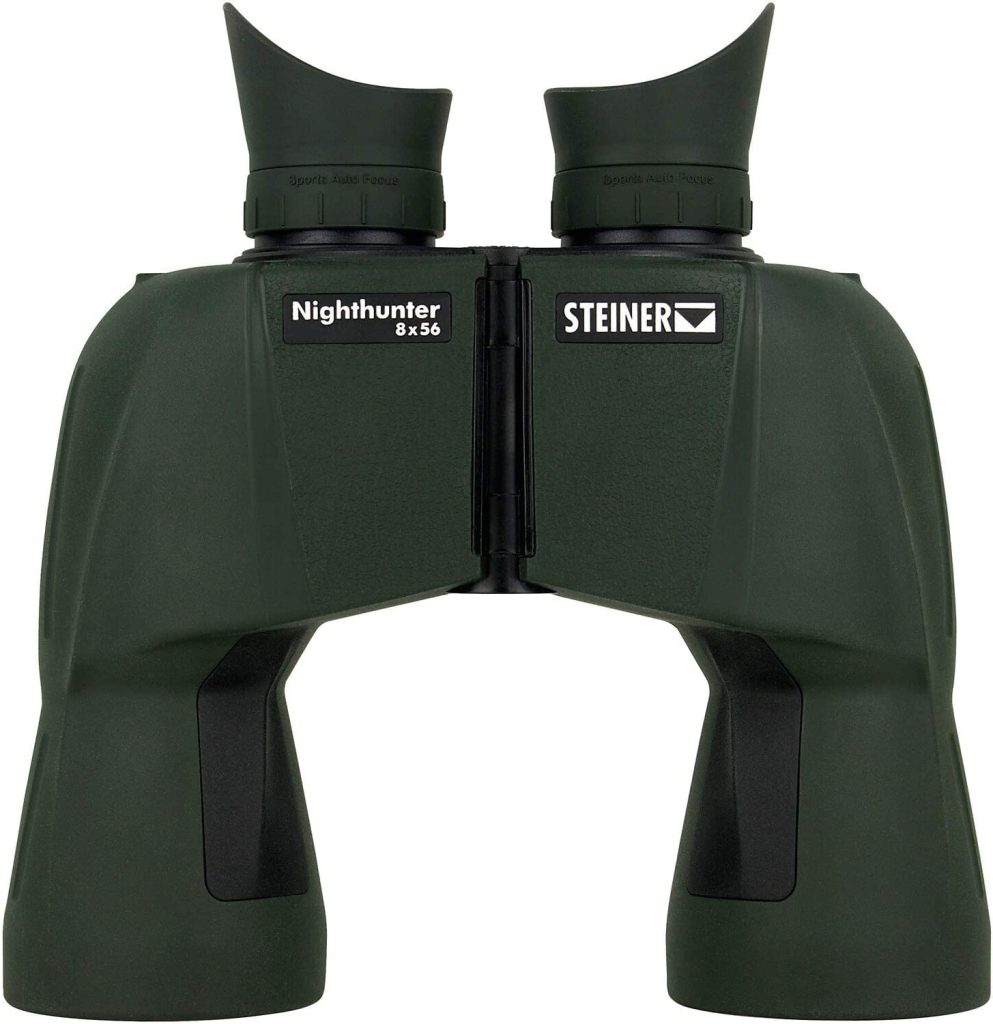
Steiner Nighhunter 8×56- Individual Focus Binoculars, Image Credit:Steiner
Step-by-Step Guide on How to Focus Binoculars with Individual Focus Wheels
- Adjust the spacing of the eyepieces to match the distance between your eyes by pulling or pushing the barrels apart or together.
- Look through the binoculars at your subject.
- Close your right eye and adjust the focus wheel on the left eyepiece until the image is clear and sharp for your left eye.
- Close your left eye and adjust the focus wheel on the right eyepiece until the image is clear and sharp for your right eye.
- Open both eyes and fine-tune the focus using the individual focus wheels until the image is clear and sharp for both eyes.
Note:
When using an individual-focus binocular, it can be difficult to focus with both eyes open.
Your brain will try to compensate for out-of-focus images, causing issues.
To avoid this, it’s best to close one eye while focusing the other.
Repeat the process for the other side.
However, it’s important to gently close each eye to avoid changing your eye focus due to excess pressure.
With practice, this technique will become natural and easy to do quickly.
Advantages Of Individual Focus systems
Binoculars with individual focus systems only need to be set once for single user.Y
You do not need to refocus between intermediate and long ranges.
SInce, both eyes adjust to the combined focal length of the lenses and focus automatically from object to object.
This also makes it easier to use them in low light conditions, when there is not enough light to readjust their focus, unlike central focus binoculars
Individual focus binoculars have improved waterproofing because each barrel is focused using a separate focus ring, making it easier for optics manufacturers to waterproof the device
Moreover, Fewer O-rings and rubber sealants are required to seal the barrels, making the development of individual focus binoculars cheaper and easier to maintain in the long run.
Here are some popular binocular models with individual focus wheels:
- Nikon Marine 7×50 IF WP
- Steiner Navigator 7×50
- Steiner 8×30 LRF 1700
- Fujinon 7×50 FMTR-SX Polaris Binoculars
- Celestron Echelon 10×70
- Steiner Nighthunter 8×56
There are some disadvantages of individual focus systems also:
Disadvantages Of Individual Focus Binoculars
- Binoculars with individual focus have a relatively larger close focus distance than central focus binoculars which limits their ability to observe objects that are comparatively nearer to the observer.
- Difficulty in sharing among multiple users due to different eyesight, and the need to adjust the barrels separately for each user can be exhausting.
- Time-consuming adjustment required for each user makes it difficult to quickly observe interesting objects during an adventurous trip.
Central Focus Binoculars vs Individual Focus Binoculars-Table
| Factors | Central Focus Binoculars | Individual Focus Binoculars |
|---|---|---|
| Focus system | One central knob for both eyes | Separate focus rings for each eye |
| Ease of use | Easy for beginners and experts | May require some practice and adjustment for individual users |
| Close focus | Can focus on objects as close as 1 meter | Better for objects at longer distances |
| Shared use | Easy to share between multiple users | Difficult to share without readjusting focus |
| Waterproofing | Difficult to effectively waterproof | Easier to waterproof due to separate focus rings |
| Low light use | Difficult to use in low light conditions | Easier to use in low light conditions due to automatic focus adjustment |
| Versatility | Good for a wide range of uses | Best suited for observing steady objects, such as hunters or military personnel |
| Price and maintenance | Affordable and easy to maintain | Costlier and may require more maintenance due to separate focus rings |
Self Focus Or Auto Focus Binoculars
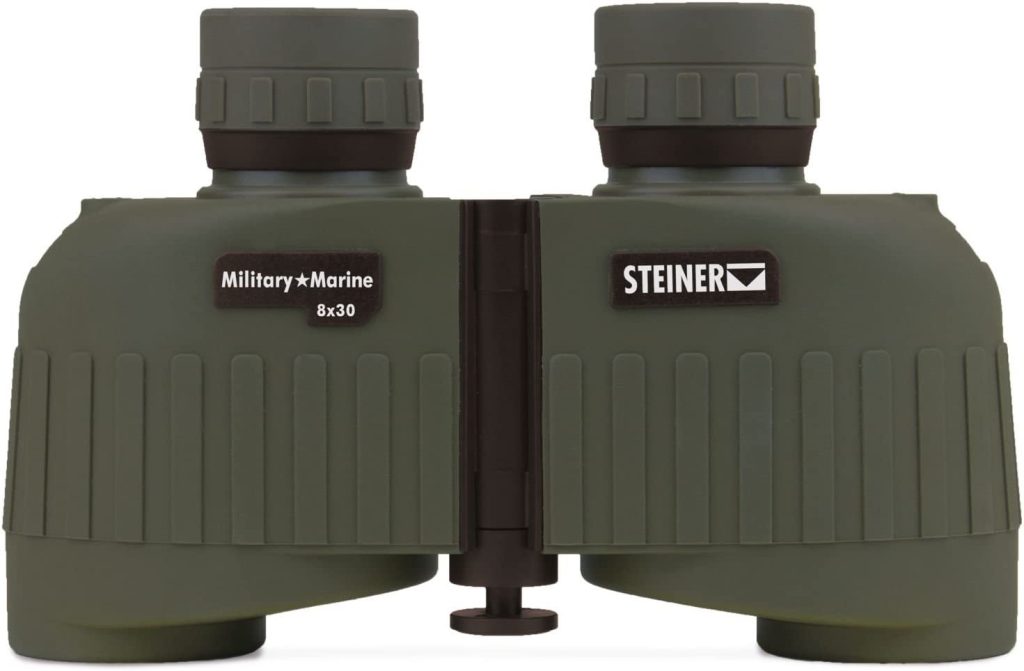
Steiner 8×30 Auto Focus Binoculars- Delivers images from 20yds to infinity without refocusing, Image Credit: Steiner
The terms “Self Focusing” or “Auto Focus” binoculars used by manufacturers are misleading and often create confusion among buyers.
These devices do not actually have an automatic focus mechanism, despite what the marketing may claim.
Instead, they are better described as fixed focus, focus-free, or always-in-focus binoculars, which have been designed to provide a fixed but long depth of view (typically from 40ft to infinity).
These binoculars do not have any focusing mechanism, and everything within the hyperfocal distance will remain in focus.
While some of these binoculars may have a diopter adjustment on each eyepiece for minor adjustments, they are not truly self-focusing or auto-focusing devices.
Here is Our Full Take On Auto Focus Binoculars
Troubleshooting and Solutions for Common Focusing Problems
- Blurry image – adjust the diopter for each eyepiece and use the focus wheel to fine-tune the focus until the image becomes clear and sharp.
- Double image – adjust the spacing between the eyepieces until the two images merge into one.
- Out-of-focus image – adjust the focus wheel until the image becomes clear and sharp.
- Dark image – adjust the lighting or move to a more well-lit area to improve visibility.
- Image not centered – adjust the spacing between the eyepieces until the image is centered in the view.
Also Check: How to adjust binoculars, Can Binoculars make me dizzy
Focusing Vs Calibrating Binoculars
The terms focus and calibration are often mistaken for one another, but they are actually distinct processes.
In essence, calibration involves making minor adjustments to your monocular or binoculars to improve their ability to focus on a subject.
To fully comprehend this distinction, it is necessary to have a basic understanding of the anatomy of your binoculars.
You can check Our article on how to use binoculars with fine adjustments here.
Factors To Consider- Focusing Binoculars Correctly
Eye Cups
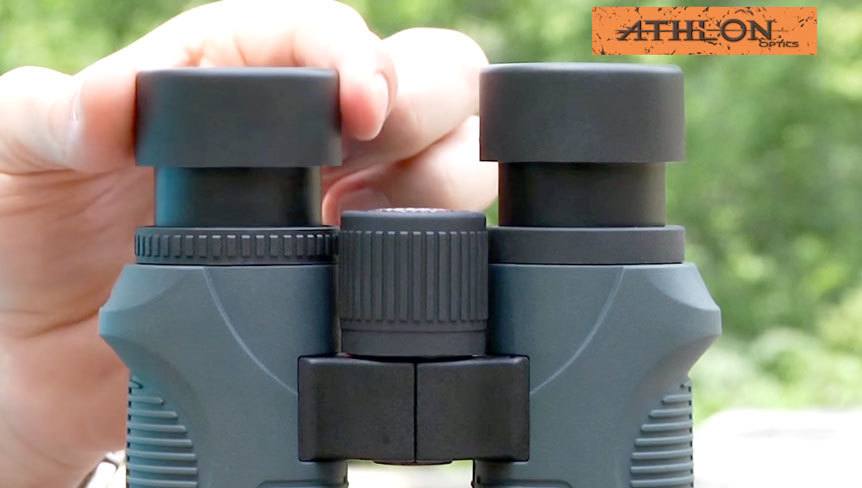
Image Credit: Athlon
To properly focus your binoculars, the first step is to adjust the eyecups to meet your visual needs.
If you do not wear glasses, you will need to rotate the eyecups counterclockwise to separate them from the barrels and bring them closer to your eyes.
This allows you to fit the binoculars to your face and block out any light from your peripheral vision.
If you wear glasses, you may need to retract the eyecups or rotate them clockwise to tighten them against the barrels.
Retracted eyecups generally create a broader view, and you can continue to tighten them clockwise to expand this image.
By adjusting the eyecups, you can ensure that you have a comfortable and clear view while using your binoculars.
It is essential to make these adjustments before attempting to focus on an object to achieve optimal results.
IPD(Inter Pupillary Distance)
To avoid eye strain and get a crystal-clear image when viewing a distant object, it is crucial to find your correct interpupillary distance (IPD). IPD refers to the distance between your pupils when your eyes are focused on something far away.
Typically, most binoculars have an inter-pupillary distance (IPD) of around 57-72 mm, which is sufficient for most people.
However, if your eyes are closer together or you’re shopping for a child , you may need an IPD that can come down to 50 mm.
On the other hand, hunters with wider-spaced eyes should look for binoculars that can range up to around 75+ mm.
To find your IPD, start by holding the binoculars in your hands and bending them to fit your face.
If you have made the correct adjustments, you should see a clear, circular image.
However, if you notice the image splitting or seeing double, you may need to adjust the binoculars further to achieve a clear shot.
By looking at the IPD, you can ensure that the binoculars are aligned with your eyes and provide you with a comfortable and clear viewing experience.
Eye Relief
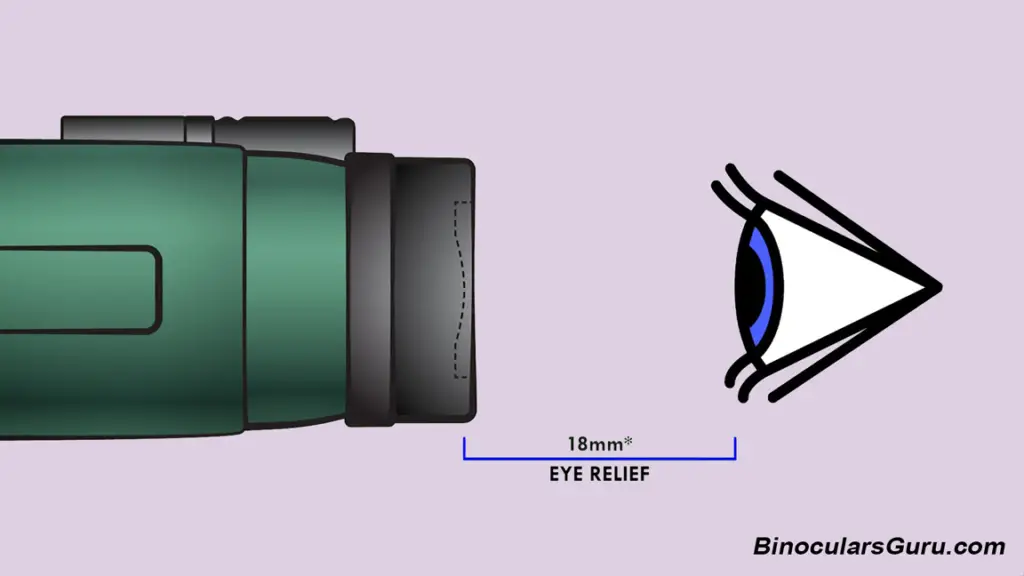
Eye relief is important in getting binoculars on focus correctly because it determines the distance between the eyepiece lens and the eye at which the full field of view is visible.
If the eye relief setting is incorrect, the image will be blurry, dark or distorted, and may cause eye strain or discomfort.
For example, if the eye relief is set too close, the user will not be able to see the entire field of view, resulting in a “tunnel vision” effect.
On the other hand, if the eye relief is set too far, the user’s eyes may not be able to align properly with the eyepieces, causing a loss of focus and a reduction in image quality.
For binoculars, a comfortable eye relief is generally considered to be around 14-16mm for most users.
However, for eyeglass wearers, a larger eye relief of 18mm or more is recommended to allow space for the eyeglasses between the eyes and the eyepiece.
Also Check: Exit Pupil Vs Twilight Factor For Image Brightess
Conclusion
Ultimately, it is the end-user’s responsibility to determine which mechanism, either central or individual focus, will best meet their requirements.
Once the decision is made, it is essential to gain knowledge about the basic operation and focus adjustment process of the selected binoculars.
Often, users do not know how to correctly adjust the focus or diopter compensation, which can nullify the benefits of using even the best-quality binoculars.
Therefore, it is crucial to understand the correct focus adjustment procedures to make the most of the binoculars.
Now That You Know All About Focusing Properly, You Can confidently Choose Binoculars In Your Budget From Below:
Check Binoculars In Your Budget:
Top Binoculars Under $300 & 400
